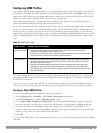
Configuring ARM Profiles
You configure ARM by defining ARM
profiles
, a set of configuration parameters that you can apply as needed to an
AP group or to individual APs. Dell controllers have one preconfigured ARM profile, called default. Most network
administrators will find that this one default ARM profile is sufficient to manage all the Dell APs on their WLAN.
Others may want to define multiple profiles to suit their APs’ varying needs.
When managing ARM profiles, you should first consider whether or not all the APs on your WLAN operate in
similar environments and manage similar traffic loads and client types.
If your APs' environment and traffic loads are mostly the same, you can use the default ARM profile to manage all
the APs on your WLAN. If you ever modify the default profile, all APs on the WLAN will be updated with the new
settings. If, however, you have APs on your WLAN that are in different physical environments, or your APs each
manage widely varying client loads or traffic types, you should consider defining additional ARM profiles for your AP
groups. The following table describes different WLAN environments, and the type of ARM profiles appropriate for
each.
ARM Profiles Example WLAN Description
default profile only l A warehouse where the physical environment is nearly the same for all APs, and each AP
manages the same number of clients and traffic load.
l A training room, where the clients are evenly spaced throughout the room, have the same security
requirements and are using the same amount of network resources.
multiple profiles l Universities where APs are in different building types (open auditoriums, small brick classrooms),
some APs must support VoIP or video streaming, and mobile clients are constantly moving from
one AP coverage area to another.
l Healthcare environments where some APs must balance the network demands of large digital
radiology files, secure electronic patient record transfers, diagnostic videos, and collaborative
VoIP sessions, while other APs (like those in a lobby or cafeteria) support only lower-priority traffic
like Internet browsing.
Table 96:
ARM Profile Types
You assign ARM profiles to AP groups by associating an ARM profile with that AP group’s 802.11a or 802.11g RF
management profile. For details on associating an ARM profile with an AP group, see “Assigning an ARM Profile to
an AP Group” on page362.
There are two ways to create a new ARM profile. You can make an entirely new profile with all default settings, or
you can create a new profile based upon the settings of an existing profile by making a copy of that other profile.
Creating a New ARM Profile
To create a new ARM profile with all default settings via the WebUI:
1. Select Configuration > All Profiles. The All Profile Management window opens.
2. Select RF Management to expand the RF Management section.
3. Select Adaptive Radio Management (ARM) Profile. Any currently defined ARM profiles appears in the right
pane of the window. If you have not yet created any ARM profiles, this pane displays the default profile only.
4. To create a new profile with all default settings, enter a name in the entry blank. The name must be 1–63
characters, and can be composed of alphanumeric characters, special characters and spaces. If your profile name
includes a space, it must be enclosed within quotation marks.
5. Click Add.
To create a new ARM profile via the command-line interface, access the CLI in config mode and issue the following
command.
DellPowerConnectW-SeriesArubaOS6.2 | User Guide AdaptiveRadioManagement (ARM) | 348


















